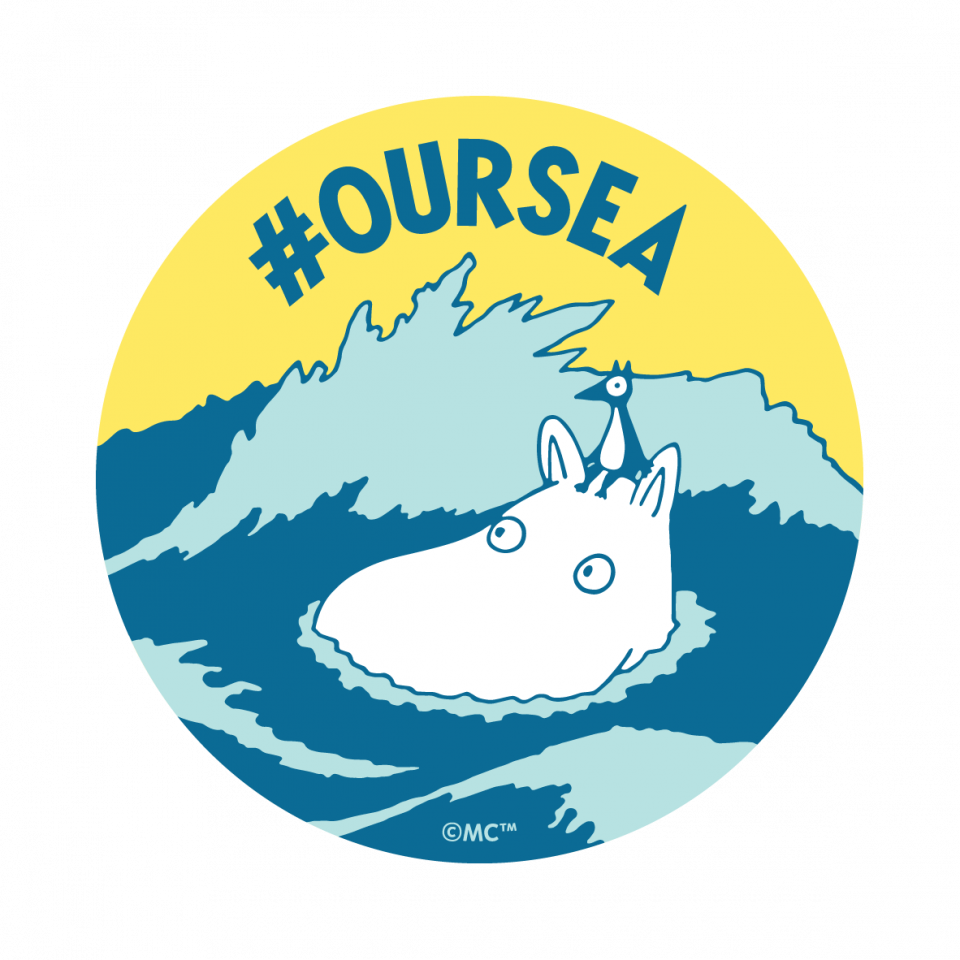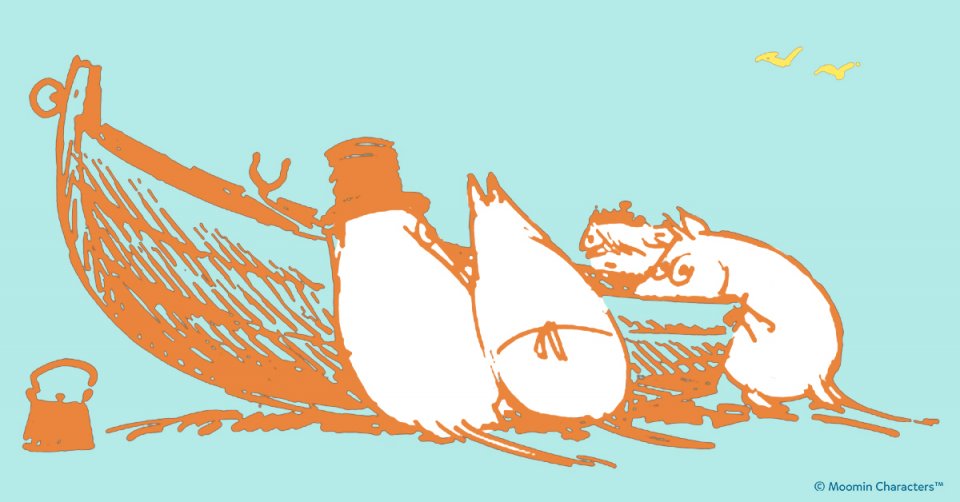Follow along on a deep sea dive with some of Tove Jansson's most beloved books as guide!
Tove Jansson often describes the sea from a windy cliffside or from a boat riding the foamy waves. But sometimes her characters dive beneath the surface, and most often they love it there. This is what it sounds like in one of Tove Jansson’s most beloved books, The Summer Book, where the little girl Sophia and her grandmother are thinking about the ultimate way to dive:
“I can dive”, Sophia said. “Do you know what it feels like when you dive?”
“Of course I do,” her grandmother said. “You let go of everything and get ready and just dive. You can feel the seaweed against your legs. It’s brown, and the water’s clear, lighter towards the top, with lots of bubbles. And you glide. You hold your breath and glide and turn and come up, let yourself rise and breathe out. And then you float. Just float.”
“And all the time with your eyes open”, Sophia said.
“Naturally. People don’t dive with their eyes shut.”
Many elements from Tove Jansson’s childhood environment can be seen in her illustrations
Even when Moomintroll dives he does it with his eyes wide open to be able to absorb the entirety of the fantastic underwater landscape that opens up to him as he encounters the sea for the first time, a wonderful moment described in Comet in Moominland.
“Pooh!” said Moomintroll diving into a big wave and swimming down through green bubbles of light. He went deeper and came upon forests of crinkly seaweed swaying gently in the current – seaweed that was decorated with beautiful white and pink shells – and even farther down the green twilight deepened until he could see only a black hole that seemed to have no bottom.
Moomintroll turned round and shot up to the surface where a big wave carried him right back to the beach.
On the picture illustrating this scene, Tove Jansson has created a stunning underwater landscape in black and white. As often seen in her drawings, there’s a visible mix between fantasy elements that only exist in Moominvalley and influences from the landscapes she herself grew up in. In many of the details one can see that Tove Jansson made some careful observations regarding nature – take for example the depiction of bladderwrack seen in the left and right sides of the picture.
Bladderwrack is one of the so called key species of the Baltic Sea, that provides nutrients and shelter for many other sea habitants. The bladderwrack kan look almost like an underwater forest if it is given freedom to grow thick around rocky shores in the Baltic Sea – almost like a local version of coral reefs. Bladderwrack acts as the lungs of the sea and offers a protected environment for fish spawn and other small animals such as shrimp and valvifera.
But not all of Jansson’s underwater landscapes are solely beautiful and transfixing
Some of the underwater depictions in the Moomin books are more fantasy based, like this passage from the Memoirs of Moominpappa where the amazing vehicle Oshun Oxtra has submerged to the bottom of the ocean, crawling across the seafloor on it’s larvae feet.
A million billion fishes came swimming from everywhere with blazing lanterns, pocket lights, searchlights, bull’s-eyes, bulbs, and acetylene lamps. Some of them carried a bracket lamp at each ear, and they were all beside themselves with joy and gratitude. The sea, a while ago so bleak, became illuminated in rainbow colours by violet, red, and chrome- yellow sea anemones on a blue lawn, and the sea serpents wheeled and turned somersaults from happiness.
We sailed home in triumph, crisscrossing over the ocean, and we never quite knew whether the lights that shone in through our portholes were stars or fishes.
For the most part Tove Jansson describes the underwater world as beautiful and breathtaking, but in Comet in Moominland, Moomintroll and his friends stumble upon a much sadder version of the ocean floor. The gravity of the oncoming comet has made the sea fall back, exposing a green and muddy ocean floor where small fish are lying around gasping for air. The almost apocalyptic vision could be an accurate description of how some parts of the Baltic Sea look today, since the eutrophication has led to many regions lacking oxygen and large parts of the plant- and animal life has disappeared.
They stood in a row and stared!
“Well, strike me pink!” said Moomintroll.
Where the sea should have been, with soft blue waves and friendly sails, there gaped a yawning abyss.
Hot steam rose from the depths of great cracks that seemed to go down to the very heart of the earth, and below them the cliff went down … down …
“Moomintroll!” gasped the Snork Maiden. “The whole sea has dried up.”
“What will the fishes say to that?” exclaimed Sniff.
The Snork took out his exercise book, and added something to the list headed: “Risks encountered during Approach of Comet”, but Snufkin sat down with his head in his hands and wailed: “Oh, dear, oh, dear, the beautiful sea quite gone. No more sailing, no more swimming, no more fishing. No great storms, no transparent ice and no gleaming black water reflecting the stars. Finished, lost, gone!”
The state of the Baltic Sea is not as dire as in Comet in Moominland but while the Baltic Sea is one of the youngest seas in the world, it’s also one of the most polluted. With the right counter measures however, we can make sure that the sea that inspired Tove Jansson in many of her wonderful illustrations starts to recuperate. It should be granted that while diving with eyes wide open, like Sophia, one gets to experience a clear sea with a vivid seafloor and a rich life.
The Moomin community to the rescue of the polluted sea
2020 marks the 75-year anniversary of Tove Jansson publishing her first Moomin novel. To celebrate the anniversary Moomin Characters Ltd has launched the one and a half year long #OURSEA campaign in collaboration with the John Nurminen Foundation.
With only 10€ you can improve the state of the sea and remove as much as 40kg of blue-green algae. You can participate in the campaign by donating on the campaign site www.oursea.fi, buy a campaign product or learn more about the threats facing the sea as well as the solutions that are being developed. Another way to participate is by spreading information about the Baltic Sea and its condition, for example by engaging you friends and colleagues – together we can do more!

At www.oursea.fi you will find more useful information on what you can do to help save the Baltic Sea – the sea that inspired Tove Jansson to create the beloved Moomin stories.

#OURSEA: From bark boats to fantastic riverboats – Tove Jansson’s literary boats
Tove Jansson’s boats, whether the real mahogany she used to travel the sea or the fantastical ones she illustrated, were a symbol of freedom.


